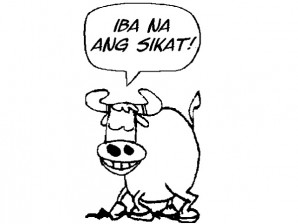
The country’s food growers would feel less of a farmer without the carabao by their side, even in today’s technological world.
So the farm festivals of various regions always have a place of honor for carabaos, according to a documentary being prepared by the Philippine Carabao Center (PCC).
Tourists have been entertained by carabaos feted at the Kneeling Carabao Festival in Pulilan, Bulacan; at the Pahiyas Festival in Lucban, Quezon; Katigbawan Festival in Catigbian, Bohol; Turogpo Festival in Barangay Camansi in Carigara, Leyte; Karbo Festival in Vigan City in Ilocos Sur; the Carabao-Carroza Festival in Pavia, Iloilo; and the Nuang Festival in San Agustin, Isabela.
Every 14th day of May, hundreds of carabaos parade on the streets of Pulilan, adorned with capes and body paint or shiny horns and hooves. As the parade passes by the Church, the carabaos are made to kneel one by one.
Carabao royalty
As the 15th day of May opens in Lucban, the town’s skyline bursts with different hues of kiping (decor) made of rice dough, vegetables, fruits, rice grains, coconuts, cottage products like buntal hats, meat products like sausages, chandeliers and miniature sets.
But the festival highlight is still the carabao grand parade, where the animals are made to pull sleds filled with the community’s best produce.
On the occasion of its founding anniversary, Catigbian in Bohol is not the tigbi (Job’s tears grass) or tigbaw (caves) from which its name was derived. Instead, it honors the carabao as the center of the festival by making them kings and queens for a day.
The festival features 22 king or queen carabaos, each representing the town’s villages.
Carabaos are also the stars of the Turogpo Festival, which is held every Black Saturday in the farming village of Camansi in Leyte.
Animal joust
Turogpo is a joust of two carabaos to test their endurance. The competing animals are made to lock horns until one animal drops off and runs away.
The first Turogpo Festival was held 400 years ago. It was then considered a form of protest because it subtly depicted community resistance to the Spanish colonizer.
In Vigan City, the Karbo Festival acknowledges the carabaos’ contribution to the city’s agriculture industry. Karbo is from the words karabaw (carabao) and bokel or seed. During the festival, carabaos become a living canvass for artists who express through paintings the theme of the festivities.
The Carabao-Carroza Festival is held every third of May. It displays a barangay’s teamwork as residents collaborate to put together the most gaily decorated carabao-carroza (carabao-drawn carriages), compete in a carabao-carroza race, and vie for the carabao-carroza festival queen.
Crossbreed capital
Gearing to become the “carabao crossbreed capital of the Philippines,” San Agustin town in Isabela holds the Nuang Festival every Sept. 28 on the occasion of its founding anniversary. Nuang is an Ilocano term for carabaos.
The raising of crossbred carabaos and propagation of carabao-based enterprises have been the town’s main preoccupation since 2005. The town has now more than 1,500 dairy carabaos. In Angono, Rizal, the art capital of the Philippines, replicas of carabaos are included in the parade of papier-mâché giants which are featured in its Higantes Festival.